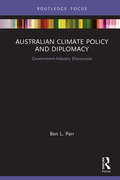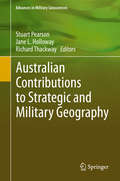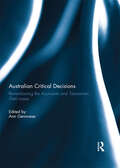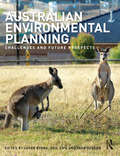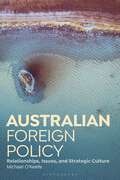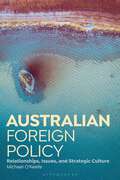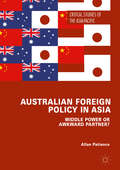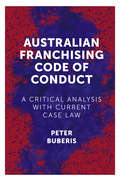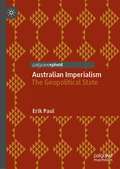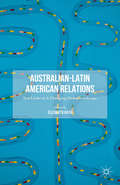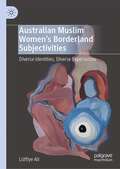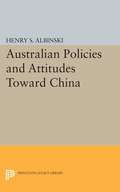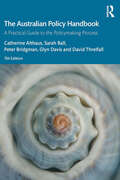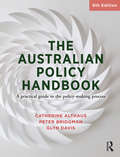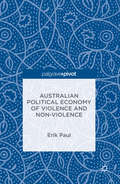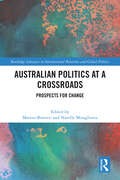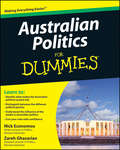- Table View
- List View
Australian Climate Policy and Diplomacy: Government-Industry Discourses (Routledge Focus on Environment and Sustainability)
by Ben L. ParrAustralian Climate Policy and Diplomacy provides a well overdue critique of existing, and high-profile, publications that convey the ‘greenhouse mafia’ hypothesis, which posits that Australia’s weak policy response to climate change is the result of a menacing domestic fossil fuel lobby. Ben L. Parr argues that the shared government–industry discourse about protecting Australia’s industrial competitiveness has had a more decisive influence in shaping and legitimising Australian climate policy than the direct lobbying tactics of the fossil fuel industry. Parr also reveals how the divergent foreign policy discourses and traditions of Australia’s two major political parties – as internationalist versus alliance-focused – have enabled and constrained their climate diplomacy and domestic policies over time. To demonstrate his argument, he presents a discourse analysis woven into a chronological policy narrative, comprising more than 1000 primary texts (media releases, interviews, and speeches) generated by prime ministers and key fossil fuel lobbyists. Overall, this volume illustrates how domestic forces have and are influencing Australia’s climate policy. In doing so, it also provides a framework that can be adapted to examine climate mitigation policies in other countries, notably Canada and the US. This book will be of interest to students and scholars of climate change, environmental policy and governance, and Australian climate change policy and politics more specifically, as well as policymakers and practitioners working in these fields.
Australian Contributions to Strategic and Military Geography (Advances in Military Geosciences)
by Stuart Pearson Jane L. Holloway Richard ThackwayDrawing from military geography’s spatial roots, its embrace of dynamic systems, and integration of human and biophysical environments, this book helps in understanding the value of analyzing patterns, processes and systems, and cross-scale and multi-disciplinary ways of acting in a complex world, while making the case for a resurgence of strategic and military geography in Australia. Here, leading experts demonstrate that geography retains its relevance in clarifying the scale and dynamics of defense activities in assessments of the international, regional, national, and site impacts of changes in physical, cyber and human geographies. The cases presented show Australia contributing to a growing strategic and military geography.
Australian Critical Decisions: Remembering Koowarta and Tasmanian Dams
by Ann GenoveseThe 1980s was a time of significant social, political and cultural change. In Australia law was pivotal to these changes. The two High Court cases that this book explores- Koowarta v Bjelke-Petersen in 1982 and the Tasmanian Dams case in 1983- are famous legally as they marked a decisive reckoning by the Court with both international law and federal constitutionalism. Yet these cases also offer a significant marker of Australia in the 1980s: a shift to a different form of political engagement, nationally and internationally, on complex questions about race, and the environment. This book brings these cases together for the first time. It does so to explore not only the legal legacy and relationship between Koowarta and Tasmanian Dams, but also to reflect on how Australians experience their law in time and place, and why those experiences might require more than the usual legal records. The authors include significant figures in Australian public life, some of whom were key participants in the cases, as well as established and respected scholars in law, history, Indigenous and environmental studies. The book offers a combination of personal recollections of the cases- the drama of how they were brought before the courts and decided- as well as a consideration of the cases’ ongoing significance in Australian life. This book was previously published as two special issues in the Griffith Law Review.
Australian Critical Decisions: Remembering Koowarta and Tasmanian Dams
by Ann GenoveseThe 1980s was a time of significant social, political and cultural change. In Australia law was pivotal to these changes. The two High Court cases that this book explores- Koowarta v Bjelke-Petersen in 1982 and the Tasmanian Dams case in 1983- are famous legally as they marked a decisive reckoning by the Court with both international law and federal constitutionalism. Yet these cases also offer a significant marker of Australia in the 1980s: a shift to a different form of political engagement, nationally and internationally, on complex questions about race, and the environment. This book brings these cases together for the first time. It does so to explore not only the legal legacy and relationship between Koowarta and Tasmanian Dams, but also to reflect on how Australians experience their law in time and place, and why those experiences might require more than the usual legal records. The authors include significant figures in Australian public life, some of whom were key participants in the cases, as well as established and respected scholars in law, history, Indigenous and environmental studies. The book offers a combination of personal recollections of the cases- the drama of how they were brought before the courts and decided- as well as a consideration of the cases’ ongoing significance in Australian life. This book was previously published as two special issues in the Griffith Law Review.
Australian Environmental Planning: Challenges and Future Prospects
by Jason Byrne Neil Sipe Jago DodsonWinner of the Planning Institute of Australia's 2015 Cutting Edge Research and Teaching Award! Australians from all walks of life have begun to realise the nation’s cities cannot sustain profligate growth indefinitely. Dwindling water supplies, failing food bowls, increased energy costs, more severe bushfires, severe storms, flooding, coastal erosion, rising transport expenses, housing shortages and environmental pollution are now daily news headlines. Australia’s cities may have reached their ecological limits: a new model for planning the places we live is needed. Understanding the natural cycles of the city is just as important to planning our cities as knowledge of local ordinances, indeed much more so. A profound knowledge of environmental processes is critical for successful planning in today’s world. Environmental planners take as their guiding principle the concept of designing with nature, approaching cities as living organisms that consume water, energy and raw materials, and produce waste. This metabolic view of cities means we can find new solutions to old problems, and steer our cities towards a more sustainable form of planning. Written specifically for students and professionals working in city planning in Australia, this ground-breaking new book enables Australian planners, architects and developers to get a better understanding of the fundamental principles of environmental planning for cities, showing how land, water, air, energy, wildlife and people shape our built environments, and how in turn environmental processes must be better understood if we are to make informed decisions about developing cities that are more sustainable. The book’s coverage is comprehensive: from an overview of the concepts and theories of environmental planning, through analysis of governance systems and urban environmental processes to agendas and policies for the future, all the key topics are covered in depth, with recommendations for supporting reading and an unrivalled selection of additional materials. Ideal for students, essential for professionals, Australian Environmental Planning is vital reading for more sustainable cities in a more sustainable world.
Australian Environmental Planning: Challenges and Future Prospects
by Jason Byrne Neil Sipe Jago DodsonWinner of the Planning Institute of Australia's 2015 Cutting Edge Research and Teaching Award! Australians from all walks of life have begun to realise the nation’s cities cannot sustain profligate growth indefinitely. Dwindling water supplies, failing food bowls, increased energy costs, more severe bushfires, severe storms, flooding, coastal erosion, rising transport expenses, housing shortages and environmental pollution are now daily news headlines. Australia’s cities may have reached their ecological limits: a new model for planning the places we live is needed. Understanding the natural cycles of the city is just as important to planning our cities as knowledge of local ordinances, indeed much more so. A profound knowledge of environmental processes is critical for successful planning in today’s world. Environmental planners take as their guiding principle the concept of designing with nature, approaching cities as living organisms that consume water, energy and raw materials, and produce waste. This metabolic view of cities means we can find new solutions to old problems, and steer our cities towards a more sustainable form of planning. Written specifically for students and professionals working in city planning in Australia, this ground-breaking new book enables Australian planners, architects and developers to get a better understanding of the fundamental principles of environmental planning for cities, showing how land, water, air, energy, wildlife and people shape our built environments, and how in turn environmental processes must be better understood if we are to make informed decisions about developing cities that are more sustainable. The book’s coverage is comprehensive: from an overview of the concepts and theories of environmental planning, through analysis of governance systems and urban environmental processes to agendas and policies for the future, all the key topics are covered in depth, with recommendations for supporting reading and an unrivalled selection of additional materials. Ideal for students, essential for professionals, Australian Environmental Planning is vital reading for more sustainable cities in a more sustainable world.
Australian Foreign Policy: Relationships, Issues, and Strategic Culture
by Michael O'KeefeHow does Australia's unique geographical, cultural and historical position influence its approach to foreign policy? What key challenges does Australia face on the world stage, and how can it overcome them? Reflecting the messy reality of foreign policy decision-making, this book helps you to understand the changes and continuities in Australia's approach. For example, does the US withdrawal from Vietnam in 1973 and collapse of South Vietnam continue to cast a shadow over Australian foreign policy, or is it relevant only in understanding the dynamics of the cold war? Using an Australian Strategic Culture framework, O'Keefe sheds light on the characteristics that make Australia behave in a way different to any other country and equips you with analytic skills to understand the main debates, such as:- In what sense could Australia be seen as a 'good' international citizen? - Have national interests trumped global responsibilities? - How does the intersection between civil society and public opinion interact with foreign policy making?This book is essential reading if you are a student of Australian foreign policy, as well as of broader Australian domestic politics and international relations.
Australian Foreign Policy: Relationships, Issues, and Strategic Culture
by Michael O'KeefeHow does Australia's unique geographical, cultural and historical position influence its approach to foreign policy? What key challenges does Australia face on the world stage, and how can it overcome them? Reflecting the messy reality of foreign policy decision-making, this book helps you to understand the changes and continuities in Australia's approach. For example, does the US withdrawal from Vietnam in 1973 and collapse of South Vietnam continue to cast a shadow over Australian foreign policy, or is it relevant only in understanding the dynamics of the cold war? Using an Australian Strategic Culture framework, O'Keefe sheds light on the characteristics that make Australia behave in a way different to any other country and equips you with analytic skills to understand the main debates, such as:- In what sense could Australia be seen as a 'good' international citizen? - Have national interests trumped global responsibilities? - How does the intersection between civil society and public opinion interact with foreign policy making?This book is essential reading if you are a student of Australian foreign policy, as well as of broader Australian domestic politics and international relations.
Australian Foreign Policy in Asia: Middle Power or Awkward Partner?
by Allan PatienceThis book sets out to discuss what kind of ‘middle power’ Australia is, and whether its identity as a middle power negatively influences its relationship with Asia. It looks at the history of the middle power concept, develops three concepts of middle power status and examines Australia’s relationships with China, Japan and Indonesia as a focus. It argues that Australia is an ‘awkward partner’ in its relations with Asia due to both its historical colonial and discriminatory past, as well its current dependence upon the United States for a security alliance. It argues this should be changed by adopting a new middle power concept in Australian foreign policy.
Australian Foreign Policy in Asia: Middle Power or Awkward Partner?
by Allan PatienceThis book sets out to discuss what kind of ‘middle power’ Australia is, and whether its identity as a middle power negatively influences its relationship with Asia. It looks at the history of the middle power concept, develops three concepts of middle power status and examines Australia’s relationships with China, Japan and Indonesia as a focus. It argues that Australia is an ‘awkward partner’ in its relations with Asia due to both its historical colonial and discriminatory past, as well its current dependence upon the United States for a security alliance. It argues this should be changed by adopting a new middle power concept in Australian foreign policy.
Australian Franchising Code of Conduct: A Critical Analysis with Current Case Law
by Peter BuberisThe Franchising Code of Conduct (the Code) is a mandatory obligation for all systems operating in Australia, and takes a comprehensive approach to disclosure, relationship laws and dispute issues. Expert author and leading practitioner Peter Buberis takes a critical view of this regulatory framework, evaluating the threads that make up the Code that directs the franchising industry in Australia. Including chapters on the areas of disclosure, good faith, and intellectual property, Buberis takes a comprehensive approach in exploring the Code's development through its consideration and enforcement by the Regulator and the courts. Looking at recent case law, the chapters indicate continuing points of concern about the Code, and give cognisance to a recent Parliamentary review which may enhance its operation if adopted. For professionals in the franchising industry, and anyone looking to understand more about the Code that governs Australia's franchises, this is a comprehensive guide that engages and analyses this key piece of legislature.
Australian Franchising Code of Conduct: A Critical Analysis with Current Case Law
by Peter BuberisThe Franchising Code of Conduct (the Code) is a mandatory obligation for all systems operating in Australia, and takes a comprehensive approach to disclosure, relationship laws and dispute issues. Expert author and leading practitioner Peter Buberis takes a critical view of this regulatory framework, evaluating the threads that make up the Code that directs the franchising industry in Australia. Including chapters on the areas of disclosure, good faith, and intellectual property, Buberis takes a comprehensive approach in exploring the Code's development through its consideration and enforcement by the Regulator and the courts. Looking at recent case law, the chapters indicate continuing points of concern about the Code, and give cognisance to a recent Parliamentary review which may enhance its operation if adopted. For professionals in the franchising industry, and anyone looking to understand more about the Code that governs Australia's franchises, this is a comprehensive guide that engages and analyses this key piece of legislature.
Australian Imperialism: The Geopolitical State
by Erik PaulIn his critical study of Australian imperialism, Erik Paul analyses the making, character and contours of the geopolitical state from the time of the British invasion and colonisation to the present, expanding the country’s continental political and economic power. War is the crucible for its hegemonic power, nationalism, and politics. The book exposes and dissects capitalist imperialism to control and manage a growing population and to impose the grand strategy of a US client state. The geopolitics in the partitioning of the earth and the exploitation of people and the biosphere continue to create major conflict, inequality, and human suffering. Australia plays an important role in the intensification of the struggle among major powers and in the outcome of an expanding global ecological and hegemonic crisis. But the existing Australian state of exception constitutes a major obstacle to a reconciliation with China and to a peaceful regional and world order.
Australian-Latin American Relations: New Links in A Changing Global Landscape
by E. KathUntil recently, Australia and Latin America were considered irrelevant to one another. The prevailing perception in Australia had been that Latin America was too remote, disconnected, and politically irrelevant to warrant serious scholarly or public attention. In recent years, this perception has rapidly changed, with Australian universities seeking to attract Latin American students, new diplomatic relations emerging, investment in mining and other business sectors expanding, and a growing fascination in Australia with Latin American food, music, dance and other forms of popular culture. These rapid developments can only properly be understood within the context of broader global transformations underway, including shifts in power relations between the 'Global North' and 'Global South', the rise of key Latin American economies, major technological developments, and ever-increasing global interconnectivity. This pioneering interdisciplinary book ventures into the new space of Australian-Latin American relations, exploring multiple dimensions of the rapidly changing landscape within a global context.
Australian Muslim Women’s Borderland Subjectivities: Diverse Identities, Diverse Experiences
by Lütfiye AliThis book claims a discursive space in academic scholarship for knowledges and ways of knowing that capture the diversity, complexity and full humanness of Australian Muslim women’s subjectivities. It draws on in-depth conversational interviews with 20 Australian Muslim women from various ethnic backgrounds during which the women shared their experiences of being at the crossroads of their religious, gendered, racialised and ethnic identities. The book puts forward a decolonial feminist border methodology by weaving the work of decolonial feminist philosophers Maria Lugones and Gloria Anzaldúa with postmodern feminist thinking on subjectivity and with discourse analysis. This methodology is used to centre and attend to the fluidity and plurality of Muslim women’s subjectivities, at the intersections of race, ethnicity, patriarchy, gender, sexuality and Islam.
Australian Policies and Attitudes Toward China (PDF)
by Henry Stephen AlbinskiAustralia, confronted by the rise of Communist China, the pressures of United States policy, and articulate interest groups within its own boundaries is attempting to adjust to its role as a "Middle Power" among major powers. All these factors are considered in this significant study.Originally published in 1966.The Princeton Legacy Library uses the latest print-on-demand technology to again make available previously out-of-print books from the distinguished backlist of Princeton University Press. These editions preserve the original texts of these important books while presenting them in durable paperback and hardcover editions. The goal of the Princeton Legacy Library is to vastly increase access to the rich scholarly heritage found in the thousands of books published by Princeton University Press since its founding in 1905.
The Australian Policy Handbook: A Practical Guide to the Policymaking Process
by Catherine Althaus Sarah Ball Peter Bridgman Glyn Davis David ThrelfallThe seventh edition of this classic handbook on the policy process is fully updated, featuring new material on policy making amid local and global disruption, the contestable nature of modern policy advice, commissioning and contracting, public engagement and policy success and failure. The Australian Policy Handbook shows how public policy permeates every aspect of our lives. It is the stuff of government, justifying taxes, driving legislation and shaping our social services. Public policy gives us roads, railways and airports, emergency services, justice, education and health services, defence, industry development and natural resource management. While politicians make the decisions, public servants provide analysis and support for those choices. This updated edition includes new visuals and introduces a series of case studies for the first time. These cases—covering family violence, behavioural economics, justice reinvestment, child protection and more—illustrate the personal and professional challenges of policymaking practice. Drawing on their extensive practical and academic experience, the authors outline the processes used in making public policy. They systematically explain the relationships between political decision makers, public service advisers, community participants and those charged with implementation. The Australian Policy Handbook remains the essential guide for students and practitioners of policy making in Australia.
The Australian Policy Handbook: A Practical Guide to the Policymaking Process
by Catherine Althaus Sarah Ball Peter Bridgman Glyn Davis David ThrelfallThe seventh edition of this classic handbook on the policy process is fully updated, featuring new material on policy making amid local and global disruption, the contestable nature of modern policy advice, commissioning and contracting, public engagement and policy success and failure. The Australian Policy Handbook shows how public policy permeates every aspect of our lives. It is the stuff of government, justifying taxes, driving legislation and shaping our social services. Public policy gives us roads, railways and airports, emergency services, justice, education and health services, defence, industry development and natural resource management. While politicians make the decisions, public servants provide analysis and support for those choices. This updated edition includes new visuals and introduces a series of case studies for the first time. These cases—covering family violence, behavioural economics, justice reinvestment, child protection and more—illustrate the personal and professional challenges of policymaking practice. Drawing on their extensive practical and academic experience, the authors outline the processes used in making public policy. They systematically explain the relationships between political decision makers, public service advisers, community participants and those charged with implementation. The Australian Policy Handbook remains the essential guide for students and practitioners of policy making in Australia.
The Australian Policy Handbook: A practical guide to the policy making process
by Glyn Davis Catherine Althaus Peter BridgmanPublic policy permeates every aspect of our lives. It is the stuff of government, justifying taxes, driving legislation, and shaping our social services. Public policy gives us roads, railways and airports, emergency services, industry development, and natural resource management. While politicians make the decisions, public servants provide analysis and support for those choices.Drawing on their extensive practical experience, the authors outline the processes used in making public policy. They systematically explain the relationships between political decision-makers, public service advisers, other community participants, and those charged with implementing the programs that result.The sixth edition of this widely used introduction is fully updated, and includes new material on the professionalisation of politicians, the role of opposition members, loss of corporate memory in the public service, addressing systemic policy failure, nudge economics and the impact of social media and the sharing economy on policy making and government.'An invaluable guide for practitioners, academics and students to the craft of policy analysis, development and evaluation. It is an important resource for those with a commitment to sound evidence-based public policy.'Ken Smith, ANZSOG CEO and Dean 'An enduring and important contribution to the field. Althaus, Bridgman and Davis' pioneering policy cycle approach continues to offer vital insights into the policy-making process in Australia and internationally.'Lisa Paul AO PSM, Former Secretary of the Department of Education
The Australian Policy Handbook: A practical guide to the policy making process
by Glyn Davis Catherine Althaus Peter BridgmanPublic policy permeates every aspect of our lives. It is the stuff of government, justifying taxes, driving legislation, and shaping our social services. Public policy gives us roads, railways and airports, emergency services, industry development, and natural resource management. While politicians make the decisions, public servants provide analysis and support for those choices.Drawing on their extensive practical experience, the authors outline the processes used in making public policy. They systematically explain the relationships between political decision-makers, public service advisers, other community participants, and those charged with implementing the programs that result.The sixth edition of this widely used introduction is fully updated, and includes new material on the professionalisation of politicians, the role of opposition members, loss of corporate memory in the public service, addressing systemic policy failure, nudge economics and the impact of social media and the sharing economy on policy making and government.'An invaluable guide for practitioners, academics and students to the craft of policy analysis, development and evaluation. It is an important resource for those with a commitment to sound evidence-based public policy.'Ken Smith, ANZSOG CEO and Dean 'An enduring and important contribution to the field. Althaus, Bridgman and Davis' pioneering policy cycle approach continues to offer vital insights into the policy-making process in Australia and internationally.'Lisa Paul AO PSM, Former Secretary of the Department of Education
Australian Political Economy of Violence and Non-Violence
by Erik PaulThis book is the first to establish the nature and causes of violence as key features in the political economy of Australia as an advanced capitalist society. Australia’s neoliberal corporate security state in seen to represent the emergence of a post-democratic order, whereby minds and bodies are disciplined to the dominant ideology of market relations. Locating questions of the democracy and of the country’s economy at the heart of Australia’s political struggle, the author elaborates how violence in Australia is built into a hegemonic order, characterized by the concentration of private power and wealth. Identifying the commodification of people and nature, the construction and manipulation of antagonisms and enemies, and the politics of fear as features of a new authoritarianism and one-party-political state, Erik Paul explores alternatives to the existing neoliberal hegemonic order. Positing that democratization requires a clearly defined counter-culture, based on the political economy of social, economic and political equality, the book draws out the potential in non-violent progressive social movements for a new political economy.
Australian Politics at a Crossroads: Prospects for Change (ISSN)
by Matteo Bonotti Narelle MiragliottaAs the 21st century proceeds apace, Australia faces new and old challenges, both domestically and internationally. These include managing complex governance issues, preventing democratic fracture, balancing an ever- shifting geopolitical strategic order, addressing the recognition and identity demands of marginalised groups, and responding to crises and urgent policy challenges, such as climate change.Bonotti, Miragliotta, and the other contributors to this volume analyse and evaluate the challenges which confront Australia by locating them in their national and comparative context. The various contributions reveal that while these challenges are neither novel nor unique to Australia, the way in which they manifest and Australia’s responses to them are shaped by the country’s distinctive history, culture, geography, location, and size.The chapters offer a cutting- edge analysis of these pressing challenges faced by Australia and offer reflections on how to address them. The book is a valuable resource for scholars and students of Australian politics, and of comparative politics in a global perspective.
Australian Politics at a Crossroads: Prospects for Change (ISSN)
As the 21st century proceeds apace, Australia faces new and old challenges, both domestically and internationally. These include managing complex governance issues, preventing democratic fracture, balancing an ever- shifting geopolitical strategic order, addressing the recognition and identity demands of marginalised groups, and responding to crises and urgent policy challenges, such as climate change.Bonotti, Miragliotta, and the other contributors to this volume analyse and evaluate the challenges which confront Australia by locating them in their national and comparative context. The various contributions reveal that while these challenges are neither novel nor unique to Australia, the way in which they manifest and Australia’s responses to them are shaped by the country’s distinctive history, culture, geography, location, and size.The chapters offer a cutting- edge analysis of these pressing challenges faced by Australia and offer reflections on how to address them. The book is a valuable resource for scholars and students of Australian politics, and of comparative politics in a global perspective.
Australian Politics For Dummies
by Nick Economou Zareh GhazarianCreated especially for the Australian customer! Understand the Australian political system and make your vote count Get to grips with the good, the bad and the ugly of Australian politics! Whether you're a seasoned political punter or a voting novice, this is your essential guide to understanding politics in Australia. Master the ins and outs of elections, parties and policies, and learn to discuss the big issues in no time. You have to vote — now learn whyand how. Decipher political terminology — clear explanations of the houses of parliament, voting systems and more Learn how Australia's political system evolved — how Westminster and Washington were combined to produce 'Washminster' Appreciate parliamentary roles — what the Whips do and just what the Usher of the Black Rod is Find out who holds the purse strings — how federal and state governments work out who pays for what Understand how political parties work — the differences between Labor and Liberal, and what coalition politics is Discover what's meant by the balance of power — how minor parties and independents contribute to politics Determine how your vote is counted — the difference between preferential voting and proportional representation Work out the media's role — how the media reports, interprets and sways political outcomes Open the book and find: Key points about past and current political hot topics Explanations of the Australian Constitution, including the crisis of 1975 Plans of the houses of parliament so you know who sits where Analysis of how the major Australian political parties came about A concise description of the electoral pendulum Graphic descriptions of the different ballot papers A comprehensive glossary of political terms and jargon Learn to: Identify what makes the Australianpolitical system tick Distinguish between the differentpolitical parties Understand the influence of the media in Australian politics Cast your vote with confidence
Australian Politics For Dummies (For Dummies Ser.)
by Nick Economou Zareh GhazarianCreated especially for the Australian customer! Understand the Australian political system and make your vote count Get to grips with the good, the bad and the ugly of Australian politics! Whether you're a seasoned political punter or a voting novice, this is your essential guide to understanding politics in Australia. Master the ins and outs of elections, parties and policies, and learn to discuss the big issues in no time. You have to vote — now learn whyand how. Decipher political terminology — clear explanations of the houses of parliament, voting systems and more Learn how Australia's political system evolved — how Westminster and Washington were combined to produce 'Washminster' Appreciate parliamentary roles — what the Whips do and just what the Usher of the Black Rod is Find out who holds the purse strings — how federal and state governments work out who pays for what Understand how political parties work — the differences between Labor and Liberal, and what coalition politics is Discover what's meant by the balance of power — how minor parties and independents contribute to politics Determine how your vote is counted — the difference between preferential voting and proportional representation Work out the media's role — how the media reports, interprets and sways political outcomes Open the book and find: Key points about past and current political hot topics Explanations of the Australian Constitution, including the crisis of 1975 Plans of the houses of parliament so you know who sits where Analysis of how the major Australian political parties came about A concise description of the electoral pendulum Graphic descriptions of the different ballot papers A comprehensive glossary of political terms and jargon Learn to: Identify what makes the Australianpolitical system tick Distinguish between the differentpolitical parties Understand the influence of the media in Australian politics Cast your vote with confidence
